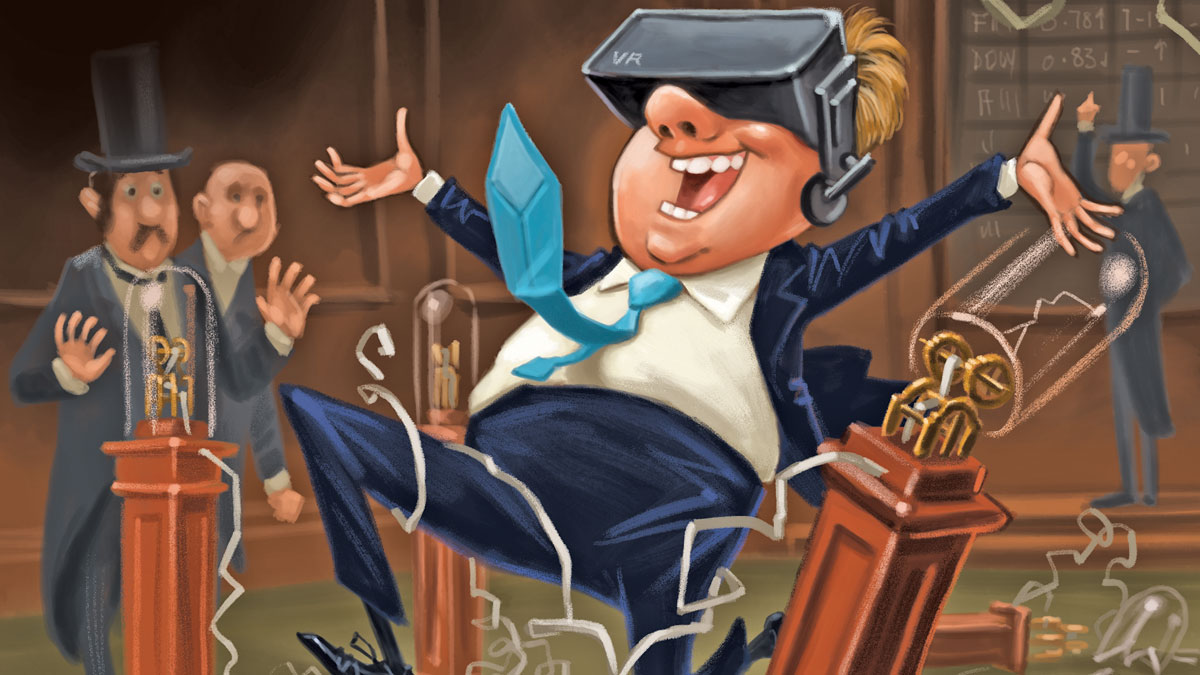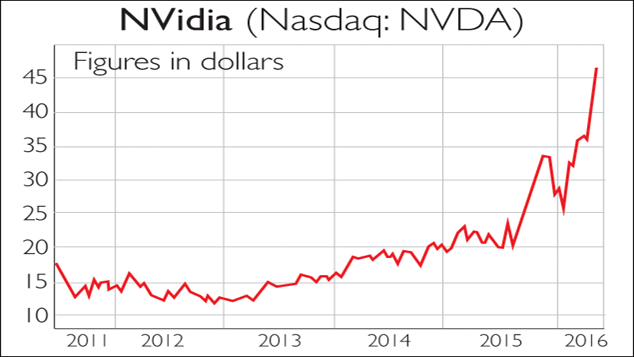Make real profits in a virtual reality
It has long been promised as “the next big thing”, but virtual reality is finally living up to its potential, says Matthew Partridge. Smart investors should buy in now.


What's the biggest sector in the entertainment industry? If you guessed music, or film, you guessed wrong. Believe it or not, the computer games industry outstrips them both combined. In 2016, gaming sales are expected to hit around $90bn, compared with $62bn spent on films, and just $18bn on music. And the business is still growing fast researchers such as Gartner estimate growth of around 8%-9% a year. It's all down to an explosion in computer processing power.
It's oft-quoted that your average smartphone now contains more computing power than the whole of America's space agency, Nasa, did when it first sent astronauts to the moon. But a more up-to-date analogy might surprise you: today's consoles and desktop PCs meet the official definition of "supercomputer" (basically, the most powerful computers in the world) as defined in Japan in 2005 little more than a decade ago.
Virtual reality: strapping the future to your face
This explosion in power has enabled ever more sophistication in gaming from "serious" gaming on consoles (such as PlayStation or Xbox), to "casual" tapping on a smartphone and other mobile devices. However, the most gripping story right now is the latest revival of virtual reality, with the hope that it can finally fulfil its promise. Virtual reality has a surprisingly long pedigree. As far back as 1963, Nasa and the US air force tried to use a crude form of virtual reality to train pilots. However, the mismatch between the view on screen and the user's physical reality had messy results. "Cadets were vomiting after only a few minutes using the headsets."
MoneyWeek
Subscribe to MoneyWeek today and get your first six magazine issues absolutely FREE

Sign up to Money Morning
Don't miss the latest investment and personal finances news, market analysis, plus money-saving tips with our free twice-daily newsletter
Don't miss the latest investment and personal finances news, market analysis, plus money-saving tips with our free twice-daily newsletter
This issue motion sickness, caused by the image on screen lagging a user's head movements has dogged virtual reality all through its regular, once-a-decade-or-so revivals as "the next big thing". But the latest generation of headsets seem to have overcome the problem. Virtual reality is on the verge of going mainstream, and it's largely down to the sheer power available to today's computers. Processing speeds for headsets such as the HTC/Steam Vive and Facebook's Oculus Rift have cut the lag to unnoticeable levels, and critics love them.
Oculus Rift "feels like strapping the future to your face", says Stuff magazine, while Vive is "VR as it's meant to be experienced". And while they're expensive, they're not prohibitively so hundreds rather than thousands of pounds. Prices are also falling all the time. The PlayStation headset, which launches in October, is priced at around $399. Other manufacturers are focusing on budget headsets that can be plugged into smartphones. Developers are already producing a flood of games for each system, with more than 200 available for Oculus Rift alone.
But virtual reality isn't just about gaming. Hollywood is jumping on the bandwagon with several top directors working on "immersive films" this year's Cannes Festival had a special line up of short films optimised for virtual reality. The technology could also have radical implications for communications.
Facebook Chief Executive Mark Zuckerberg hopes that Oculus Rift will render business travel redundant. In 2015, Google launched its Google Expeditions programme to allow US students to experience "virtual field trips" to landmarks around the world. It also has potentially revolutionary uses in medicine and mechanical engineering, as Treacy notes below.
At this stage, it's impossible to predict just how large the market could be. Bloomberg Intelligence conservatively predicts that shipments of virtual reality hardware will hit $2.8bn by 2020 market research firm Digi-Capital goes to the opposite end of the spectrum, reckoning the market could be worth as much as $30bn by then. But clearly the potential is huge.
Huge potential, and not just for teenagers
For now, traditional gaming is the biggest part of the games industry. You need only look at the budgets dedicated to the biggest blockbuster games to see just how significant this business is. Take science-fiction role-playing game Fallout 4, released last November. It took four years for the producers, Bethesda, to develop, with a team of around 200 people (not including the voice actors employed on the game), and a total budget of at least $90m, according to industry insiders. Yet that was a bargain compared with 2013's Grand Theft Auto V, which cost $265m to make.
Such huge spending can only be justified by good "box office" and these games have more than delivered. A copy of Fallout 4 costs anything from £35 to £100 for a special edition expensive compared with most rival forms of entertainment. Yet sales hit $750m within 24 hours of its release. Digital distribution (downloading online, rather than buying a game in a shop) has also opened up new revenue streams for companies, who can sell downloadable new content or multiplayer versions for existing games.
As a result, there are now several billion-dollar game franchises Activision's Call of Duty series has generated more than $10bn in sales. For perspective, that's significantly more than the total box office for all of the Star Wars films to date.
The industry is also expanding its appeal beyond the traditional male teenage demographic. The average US gamer is now 35, reports the Entertainment Software Association, and there are nearly as many female as male gamers (roughly a 56%/44% split). America is the biggest single market, growing at a solid 5% a year, but Asian sales are expanding at a double-digit rate. People now play games professionally for money this year, the University of California, Irvine became the first major institution to offer "e-sports" scholarships.
The situation is also rosy for hardware manufacturers, with console sales continuing to grow. Ultra-fast streaming services might in future allow external computers to carry out all the processing tasks, doing away with the need for consoles entirely. However, this is unlikely in the short or medium term the sheer size of today's games means that broadband connections would have to be much faster and more reliable than they are at present.
Going mobile
Console games tend to be in-depth, time-consuming adventures for "serious" gamers. At the other end of the scale, there's the casual gaming market, dominated by mobile games. All of those people you see fiddling with rows of sweeties or gems on their phones and tablets on the train to work? They're casual gamers.
Estimates for the size of this market range widely from $22bn (Gartner) to $35bn (App Annie). But it's clear the business is booming, and that it's not cannibalising sales from the serious gaming sector it's a separate phenomenon, and one that reaches demographics games companies traditionally find hard to get to (such as middle-aged women).
Mobile gaming has two main business models: you can charge a one-off fee to buy the entire game, or you can opt for the "freemium" route, where the initial download is free, and the aim isto persuade users to pay for in-game content, such as extra levels or extra turns, for example.
Candy Crush Saga launched in 2012 is still perhaps the best example of a freemium success. Less than 3% of users pay for the game, yet it raked in $1.3bn in 2014 alone. Mobile gaming is also giving old favourites a new lease of life, with several companies releasing re-mastered copies of games that were popular in the 1980s, 1990s and 2000s.
Even Nintendo which had resisted going mobile to protect sales of its own consoles has taken the plunge with releases from its back catalogue, while titles from popular franchises (such as Call of Duty), with simplified game play, are being tailor-made for mobile. As an investor, it's increasingly hard to ignore the gaming business we look at the best stocks to buy now in the box on the previous pages.
The six stocks to buy now
One picks-and-shovels play on virtual realityheadsets is NVidia (Nasdaq:NVDA). The latest games, especiallythose involving virtual reality, requireextremely powerful graphical processingunits, or graphics cards, to keepeverything moving seamlessly on screenand avoid motion sickness. That's whatNVidia makes. Its latest model, the GTX1080, has just been released to generalacclaim and the Oculus Rift and Viveheadsets both use the NVidia GeForceVR chip. The company is also developing artificial intelligence technologies basedaround "deep learning", another fast-growingarea.
There are always risks withnew technology as Eoin Treacy of the Frontier Tech Investor newsletter pointsout, the biggest risk to NVidia is that arival comes up with a better product.But "perhaps the greatest risk is thatconsumers do not take to virtual realityimmediately, which would slow thepace of product development and wouldupset the company's sales trajectory".Current annual sales growth of around10% justifies the 2017 price/earnings (p/e)ratio of 21. NVidia also pays a small butgrowing dividend, and is buying backshares at a rate of $1bn a year.

Another option on the hardware side isIntel (Nasdaq: INTC). Intel is the largestmanufacturer of computer chips. Justas most users will have to upgrade theirgraphics cards if they want to use virtualreality, they will also have to buy morepowerful computers. Intel has investedheavily in augmented reality, a similartechnology to virtual reality, wherecomputer images are combined withreal life images an approach currentlyfavoured by Microsoft.
Intel has alsoshowcased eye-tracking technology thatcould be used in future virtual-realitysystems to remove the need for physicalcontrollers. Intel is on a 2017 p/e of 11.6.Games publishing is a risky business,dependent on the constant productionof "hits". However, this risk can beoffset somewhat by investing in thebiggest players.
Activision Blizzard(Nasdaq: ATVI) is the world's fifth-largestgames company. Its franchises includeDestiny, Call of Duty, World of Warcraftand Skylanders. It owns mobile gamespublisher King, which developed mega hitCandy Crush Saga, and is developingFacebook-based versions of its majorgames, which should greatly boostrevenue. It isn't cheap on 20.8 times 2016earnings, but sales are growing at around10% a year and there is plenty of cash onhand.
Another option is Electronic Arts(Nasdaq: EA), which publishes a widerange of games, including the mega hitFIFA football series and the highlyanticipated Battlefield 1 combat game.EA has been very successful at movingonline, with digital distribution nowaccounting for over half of revenue. Italso has a fast-growing mobile segment.Earnings are expected to keep growingat a double-digit rate, and the p/e is 20.7.
Finally, there's French developer Ubisoft(PAR: UBI), which plans to boost salesgrowth both by selling more games,and by persuading individual gamers tospend more on add-ons. Ubisoft is alsoturning its biggest franchises into films.A film based on the Assassin's Creedseries is due to be released in December,followed by at least two sequels. Ubisoftis also investing significantly in virtualreality. It's on 17.4 times 2018 earnings.
One way in to earlier-stage firms is viaMercia Technologies (LSE: MERC). Thisventure-capital trust specialises in smalltechnology firms, especially those linkedto UK universities. Investments includenDreams, a firm focusing on virtualreality games, Soccer Manager, a fast-growinggame, and Edge Case Games,which develops online games that arefree to play. Mercia trades at a 15%premium to the value of its net assets.
The future is virtual
Imagine a future where virtual reality is an established technology, says Eoin Treacey. What if you never had to visit a physical office? Conferences are already taking place in webinar environments, but these forums don't have the same networking potential as physica locations. But throw in a virtual forum, with convincing avatars and reliable internet connectivity, and we could rapidly close the experience gap between the virtual and physical forums, saving us all time on travel.
You won't be moving to an island paradise anytime soon but being able to work largely in a virtual office and live further out of the city would be a good start.
Health care would be revolutionised. Operations could be carried out by robots controlled by skilled surgeons operating at distance. The virtual reality headset would magnify every tissue and enable incredible precision. The interactivity of the experience will mean the surgeon will be able to sense the success or otherwise of her actions immediately and take rapid corrective action. Surgical success rates will soar.
Or what about engineering? Rather than hammer out the specifications for a component, wait for it to be 3-D printed, and then fit it to an expensive prototype, mechanical engineers will be able to do all of this within a virtual workspace. Product development will accelerate because the engineer will be able to look, see and feel how well the part performs. And this points to where virtual reality's greatest value will arguably lie in enabling us to create whatever we can imagine in a virtual form, which will then be translated into physical reality by machines.
As robots start to encroach on existing jobs, virtual reality may be the key tool that allows us to enhance our creativity our main advantage over the machines because it offers the most seamless interface yet with our imaginations. This will create a whole new swathe of industries and jobs to replace those subsumed in the next wave of automation.
Get the latest financial news, insights and expert analysis from our award-winning MoneyWeek team, to help you understand what really matters when it comes to your finances.

-
 How cancelling unused direct debits could boost your pension by £37,000
How cancelling unused direct debits could boost your pension by £37,000A new year refresh of your spending could save you money and help boost your pension pot.
-
 NS&I cuts interest rates on 8 savings accounts
NS&I cuts interest rates on 8 savings accountsNS&I will now offer less attractive interest rates for customers wishing to lock their savings away to grow for one, two, three or five years.
-
 Governments will sink in a world drowning in debt
Governments will sink in a world drowning in debtCover Story Rising interest rates and soaring inflation will leave many governments with unsustainable debts. Get set for a wave of sovereign defaults, says Jonathan Compton.
-
 Why Australia’s luck is set to run out
Why Australia’s luck is set to run outCover Story A low-quality election campaign in Australia has produced a government with no clear strategy. That’s bad news in an increasingly difficult geopolitical environment, says Philip Pilkington
-
 Why new technology is the future of the construction industry
Why new technology is the future of the construction industryCover Story The construction industry faces many challenges. New technologies from augmented reality and digitisation to exoskeletons and robotics can help solve them. Matthew Partridge reports.
-
 UBI which was once unthinkable is being rolled out around the world. What's going on?
UBI which was once unthinkable is being rolled out around the world. What's going on?Cover Story Universal basic income, the idea that everyone should be paid a liveable income by the state, no strings attached, was once for the birds. Now it seems it’s on the brink of being rolled out, says Stuart Watkins.
-
 Inflation is here to stay: it’s time to protect your portfolio
Inflation is here to stay: it’s time to protect your portfolioCover Story Unlike in 2008, widespread money printing and government spending are pushing up prices. Central banks can’t raise interest rates because the world can’t afford it, says John Stepek. Here’s what happens next
-
 Will Biden’s stimulus package fuel global inflation – and how can you protect your wealth?
Will Biden’s stimulus package fuel global inflation – and how can you protect your wealth?Cover Story Joe Biden’s latest stimulus package threatens to fuel inflation around the globe. What should investors do?
-
 What the race for the White House means for your money
What the race for the White House means for your moneyCover Story American voters are about to decide whether Donald Trump or Joe Biden will take the oath of office on 20 January. Matthew Partridge explains how various election scenarios could affect your portfolio.
-
 What’s worse: monopoly power or government intervention?
What’s worse: monopoly power or government intervention?Cover Story Politicians of all stripes increasingly agree with Karl Marx on one point – that monopolies are an inevitable consequence of free-market capitalism, and must be broken up. Are they right? Stuart Watkins isn’t so sure.